Influence Factor Analysis and Prediction Model of End-Point Carbon Content Based on Artificial Neural Network in Electric Arc Furnace Steelmaking Process
Abstract
:1. Introduction
2. Model Structure and Modeling Method
2.1. Artificial Neural Network (ANN) Method
2.2. Model Development Tool
3. Establishment of Prediction Model
3.1. Model Input and Output Variables Selection
3.2. Establishment of Artificial Neural Network Model
3.3. Improvement of Prediction Model
3.4. Influence Factor Analysis
4. Model Applications
4.1. Model Interface and Function
4.2. Model Analysis and Discussion
- (1)
- The molten steel fluidity of the bath in the EAF is poor, the chemical reaction is not balanced, and the composition and temperature difference are large, which affects the judgment of the matching relationship between the chemical reaction in the furnace and the metallurgical reaction intensity and smelting process in the furnace.
- (2)
- Due to the large fluctuation of raw material composition, the end-point carbon content of EAF is affected by some real-time changes such as furnace condition and slag. The accuracy of the prediction model is also affected by various factors.
- (3)
- The data collection of various influencing factors of carbon content at EAF endpoint is affected by analysis equipment and personnel operation, which affects the accuracy of data and prediction model.
5. Conclusions
Author Contributions
Funding
Institutional Review Board Statement
Informed Consent Statement
Data Availability Statement
Conflicts of Interest
References
- Toulouevski, Y.N.; Zinurov, I.Y. (Eds.) Innovation in Electric Arc Furnaces: Scientific Basis for Selection; Springer: Berlin/Heidelberg, Germany, 2013; pp. 1–24. [Google Scholar]
- He, F.; Zhang, L. Prediction model of end-point phosphorus content in BOF steelmaking process based on PCA and BP neural network. J. Process Control. 2018, 66, 51–58. [Google Scholar] [CrossRef]
- Liu, Q.; Wang, B.; Wang, Z.; Wang, B.; Xie, F.; Chang, J. Fine Production in Steelmaking Plants. Mater. Today Proc. 2015, 2, S348–S357. [Google Scholar] [CrossRef]
- De Oliveira Campos, L.D.; Gardin, P.; Vincent, S.; Caltagirone, J.P. Mass Transfer Prediction between Liquid Steel and Slag in Steelmaking Processes. In Proceedings of the 7th International Conference on Modelling and Simulation of Metallurgical Processes in Steelmaking, Qingdao, China, 16–18 August 2017; 2017; pp. 120–123. [Google Scholar]
- Morales, A.T. Thermodynamics and Kinetics of Manganese Smelting in Steelmaking. Doctoral Dissertation, Carnegie Mellon University, Pittsburgh, PA, USA, 1994. [Google Scholar]
- Sarkar, R.; Gupta, P.; Basu, S.; Ballal, N.B. Dynamic Modeling of LD Converter Steelmaking: Reaction Modeling Using Gibbs’ Free Energy Minimization. Met. Mater. Trans. A 2015, 46, 961–976. [Google Scholar] [CrossRef]
- Shukla, A.K.; Deo, B.; Millman, S.; Snoeijer, B.; Overbosch, A.; Kapilashrami, A. An Insight into the Mechanism and Kinetics of Reactions In BOF Steelmaking: Theory vs Practice. Steel Res. Int. 2010, 81, 940–948. [Google Scholar] [CrossRef]
- Wang, B.H.; Yang, L.Z.; Guo, Y.F. Present situation composition forecast in EAF steelmaking and influence of molten bath stirring. China Metall. 2017, 12, 1–7. [Google Scholar]
- Wei, G.; Wang, Y.; Zhu, R.; Yang, L. Influence of Desulfurization with Fe2O3 on the Reduction of Nickel Converter Slag. Materials 2020, 13, 2423. [Google Scholar] [CrossRef]
- Feng, K.; Xu, A.; He, D.; Yang, L. Case-based Reasoning Method based on Mechanistic Model Correction for Predicting Endpoint Sulfur Content of Molten Iron in KR Desulfurization. Ironmak. Steelmak. 2020, 47, 799. [Google Scholar] [CrossRef]
- Widomski, P.; Zwierzchowski, M.; Barełkowski, A.; Tympalski, M. Case Study of the Effect of Precoating on the Decarburization of the Surface Layer of Forged Parts during the Hot Die Forging Process. Materials 2021, 14, 422. [Google Scholar] [CrossRef]
- Wei, G.-S.; Zhu, R.; Yang, L.; Tang, T. Hybrid Modeling for Endpoint Carbon Content Prediction in EAF Steelmaking. Mater. Process. Fundam. 2018, 2018, 211–224. [Google Scholar] [CrossRef]
- Yuan, P.; Mao, Z.-Z.; Wang, F.-L. Endpoint Prediction of EAF Based on Multiple Support Vector Machines. J. Iron Steel Res. Int. 2007, 14, 20–24. [Google Scholar] [CrossRef]
- Zhang, S.; Mao, X.; Mao, X. The research of end-point prediction based on combination model of electric arc furnace. In Proceedings of the 5th IEEE Conference on Industrial Electronics and Applicationsis, Taichung, Taiwan, 15–17 June 2010; pp. 1531–1536. [Google Scholar] [CrossRef]
- Liu, C.; Tang, L.; Liu, J. A Stacked Autoencoder With Sparse Bayesian Regression for End-Point Prediction Problems in Steelmaking Process. IEEE Trans. Autom. Sci. Eng. 2020, 17, 550–561. [Google Scholar] [CrossRef]
- Liu, K.; Liu, L.; Ping, H.; Shen, J.-X.; Sun, Y.-X.; Meng, L. Study on prediction of end point carbon content and temperature in EAF steelmaking by incremental model. Metall. Ind. Autom. 2007, 31, 5–8. [Google Scholar]
- Yuan, P.; Wang, F.L.; Mao, Z.Z. CBR Based Endpoint Prediction of EAF. J. Northeast. Univ. 2011, 32, 1673–1676. [Google Scholar]
- Zhu, Y.P.; Zhao, X.D.; Xu, S.L. Predictive Model for BOF Steelmaking using RBF Neural Network. Appl. Mech. Mater. 2011, 58, 1214–1218. [Google Scholar] [CrossRef]
- Wang, G.; Kong, X.; Zhang, Z.; Zhao, W.; Gao, S.; Xu, X. Based on BP network terminal quality prediction for BOF steelmaking process. In Proceedings of the 2010 Chinese Control and Decision Conference, Xuzhou, China, 26–28 May 2010; pp. 2663–2667. [Google Scholar] [CrossRef]
- Torquato, M.F.; Martinez-Ayuso, G.; Fahmy, A.A.; Sienz, J. Multi-Objective Optimization of Electric Arc Furnace Using the Non-Dominated Sorting Genetic Algorithm II. IEEE Access 2021, 9, 149715–149731. [Google Scholar] [CrossRef]
- Kačur, J.; Flegner, P.; Durdán, M.; Laciak, M. Prediction of Temperature and Carbon Concentration in Oxygen Steelmaking by Machine Learning: A Comparative Study. Appl. Sci. 2022, 12, 7757. [Google Scholar] [CrossRef]
- Wang, Z.; Bao, Y.; Gu, C. Convolutional neural network-based method for predicting oxygen content at the end point of converter. Steel Res. Int. 2022. [Google Scholar] [CrossRef]
- Kordos, M.; Blachnik, M.; Wieczorek, T. Temperature Prediction in Electric Arc Furnace with Neural Network Tree. In Artificial Neural Networks and Machine Learninge ICANN; Springer: Berlin/Heidelberg, Germany, 2011; pp. 71–78. [Google Scholar] [CrossRef]
- Fernandez, J.M.M.; Cabal, V.A.; Montequin, V.R.; Balsera, J.V. Online estimation of electric arc furnace tap temperature by using fuzzy neural networks. Eng. Appl. Artif. Intel. 2008, 21, 1001–1012. [Google Scholar] [CrossRef]
- Wang, F.; Jin, Z.; Zhu, Z. Modeling and Prediction of Electric Arc Furnace Based on Neural Network and Chaos Theory. In Advances in Neural Networkse ISNN; Springer: Berlin/Heidelberg, Germany, 2005; pp. 819–826. [Google Scholar]
- Ansari, O.; Chattopadhyaya, S.; Ghose, J.; Sharma, S.; Kozak, D.; Li, C.; Wojciechowski, S.; Dwivedi, S.P.; Kilinc, H.C.; Królczyk, J.B.; et al. Productivity Enhancement by Prediction of Liquid Steel Breakout during Continuous Casting Process in Manufacturing of Steel Slabs in Steel Plant Using Artificial Neural Network with Backpropagation Algorithms. Materials 2022, 15, 670. [Google Scholar] [CrossRef]
- Roshani, G.H.; Nazemi, E.; Roshani, M.M. Flow regime independent volume fraction estimation in three-phase flows using dual-energy broad beam technique and artificial neural network. Neural Comput. Appl. 2016, 28, 1265–1274. [Google Scholar] [CrossRef]
- Alshawarghi, H.; Elkamel, A.; Moshiri, B.; Hourfar, F. Predictive models and detection methods applicable in water detection framework for industrial electric arc furnaces. Comput. Chem. Eng. 2019, 128, 285–300. [Google Scholar] [CrossRef]
- He, F.; He, D.-F.; Xu, A.-J.; Wang, H.-B.; Tian, N.-Y.; Tian, N.-Y. Hybrid Model of Molten Steel Temperature Prediction Based on Ladle Heat Status and Artificial Neural Network. J. Iron Steel Res. Int. 2014, 21, 181–190. [Google Scholar] [CrossRef]
- Sun, Y.-J.; Zhang, S.; Miao, C.-X.; Li, J.-M. Improved BP Neural Network for Transformer Fault Diagnosis. J. China Univ. Min. Technol. 2007, 17, 138–142. [Google Scholar] [CrossRef]
- Sattari, M.A.; Roshani, G.H.; Hanus, R.; Nazemi, E. Applicability of time-domain feature extraction methods and artificial intelligence in two-phase flow meters based on gamma-ray absorption technique. Measurement 2021, 168, 108474. [Google Scholar] [CrossRef]
- Malinovsky, V. Comparative analysis of freigjt transport prognoses results provided by transport system model and neural network. Neural Netw. World 2021, 31, 239–259. [Google Scholar] [CrossRef]
- el Hindi, K.; Mousa, A.A. Smoothing decision boundaries to avoid overfitting in neural network training. Neural Netw. World 2021, 21, 311–325. [Google Scholar] [CrossRef] [Green Version]
- Manojlović, V.; Kamberović, Ž.; Korać, M.; Dotlić, M. Machine learning analysis of electric arc furnace process for the evaluation of energy efficiency parameters. Appl. Energy 2021, 307, 118209. [Google Scholar] [CrossRef]
- Kadrolkar, A.; Dogan, N. The Decarburization Kinetics of Metal Droplets in Emulsion Zone. Met. Mater. Trans. A 2019, 50, 2912–2929. [Google Scholar] [CrossRef]
- Yang, Z.S.; Yang, L.Z.; Ting, C.; Chen, F.; Zheng, F.Q.; Wang, S. Fluid flow characteristic of EAF molten steel with different bottom-blowing gas flow rate distributions. ISIJ Int. 2020, 60, 1957–1967. [Google Scholar] [CrossRef] [Green Version]
- Rout, B.K.; Brooks, G.; Rhamdhani, M.A.; Li, Z.; Schrama, F.N.H.; Overbosch, A. Dynamic Model of Basic Oxygen Steelmaking Process Based on Multizone Reaction Kinetics: Modeling of Decarburization. Met. Mater. Trans. A 2018, 49, 1022–1033. [Google Scholar] [CrossRef]
- Lee, B.; Sohn, I. Effect of hot metal on decarburization in the eaf and dissolved sulfur, phosphorous, and nitrogen content in the steel. ISIJ Int. 2015, 55, 491–499. [Google Scholar] [CrossRef] [Green Version]
- Matsuura, H.; Tsukihashi, F. Conversion of CO2 Gas to CO Gas by the Utilization of Decarburization Reaction during Steelmaking Process. ISIJ Int. 2015, 55, 413–418. [Google Scholar] [CrossRef] [Green Version]
- Zhang, J.; Liu, L.; Zhao, X.; Lei, S.; Dong, Q. Mathematical Model for Decarburization Process in RH Refining Process. ISIJ Int. 2014, 54, 1560–1569. [Google Scholar] [CrossRef] [Green Version]
- Fujii, T. Effect of carbon in molten steel and gaseous oxygen on the rate of decarbonization: Kinetics of decarbonization in molten steel iii. Tetsu Hagane 2009, 45, 1248–1254. [Google Scholar] [CrossRef]

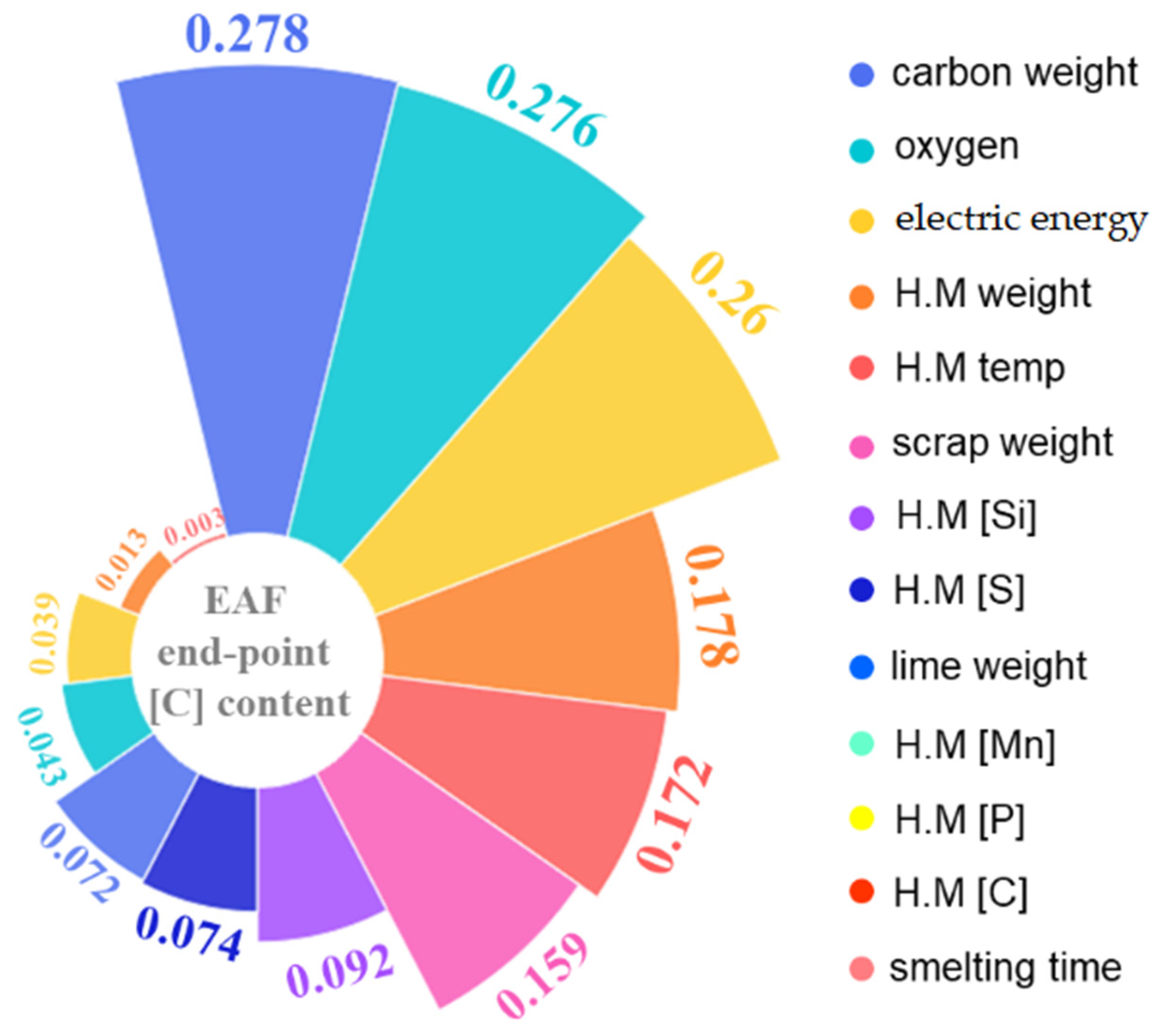
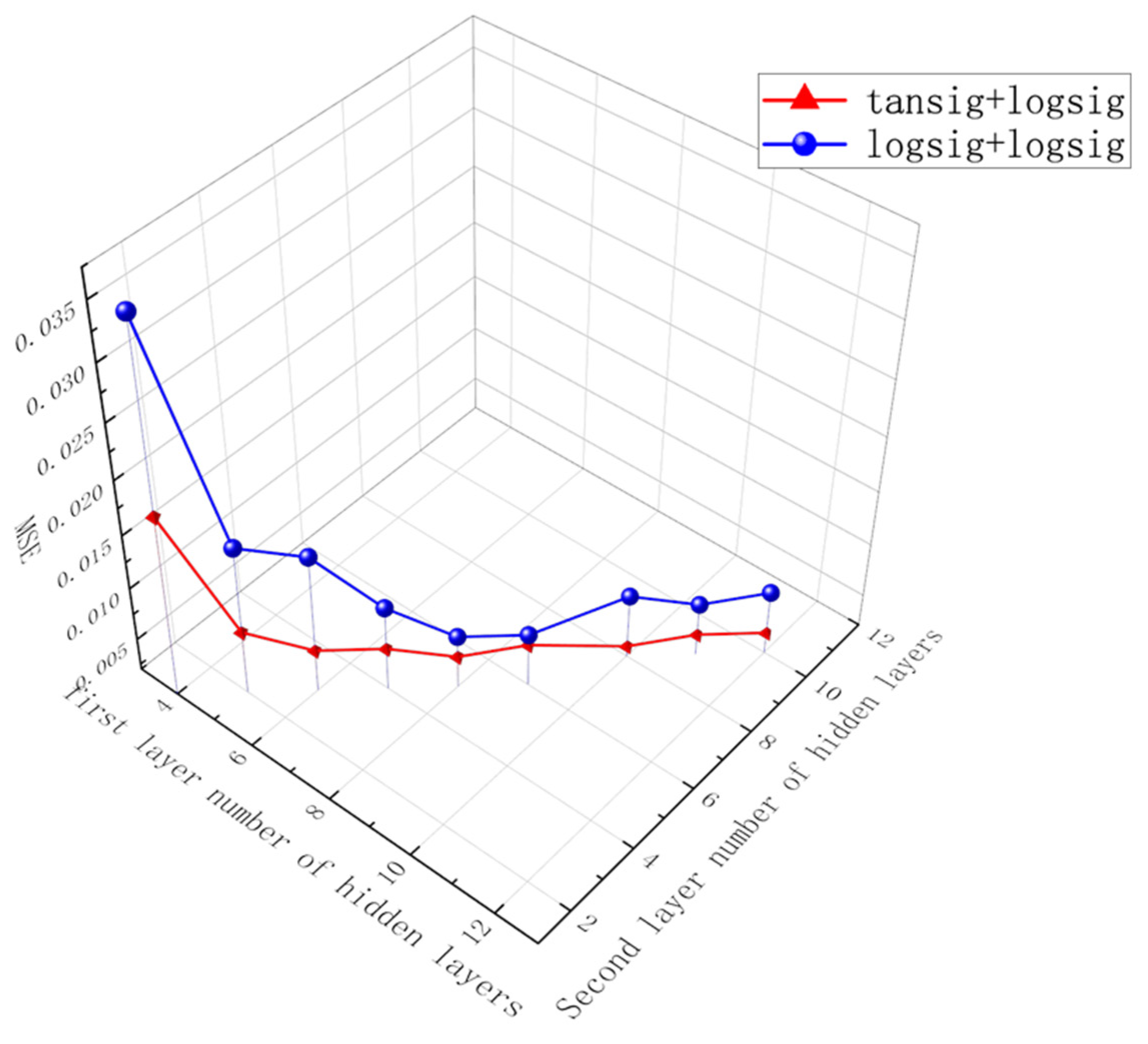

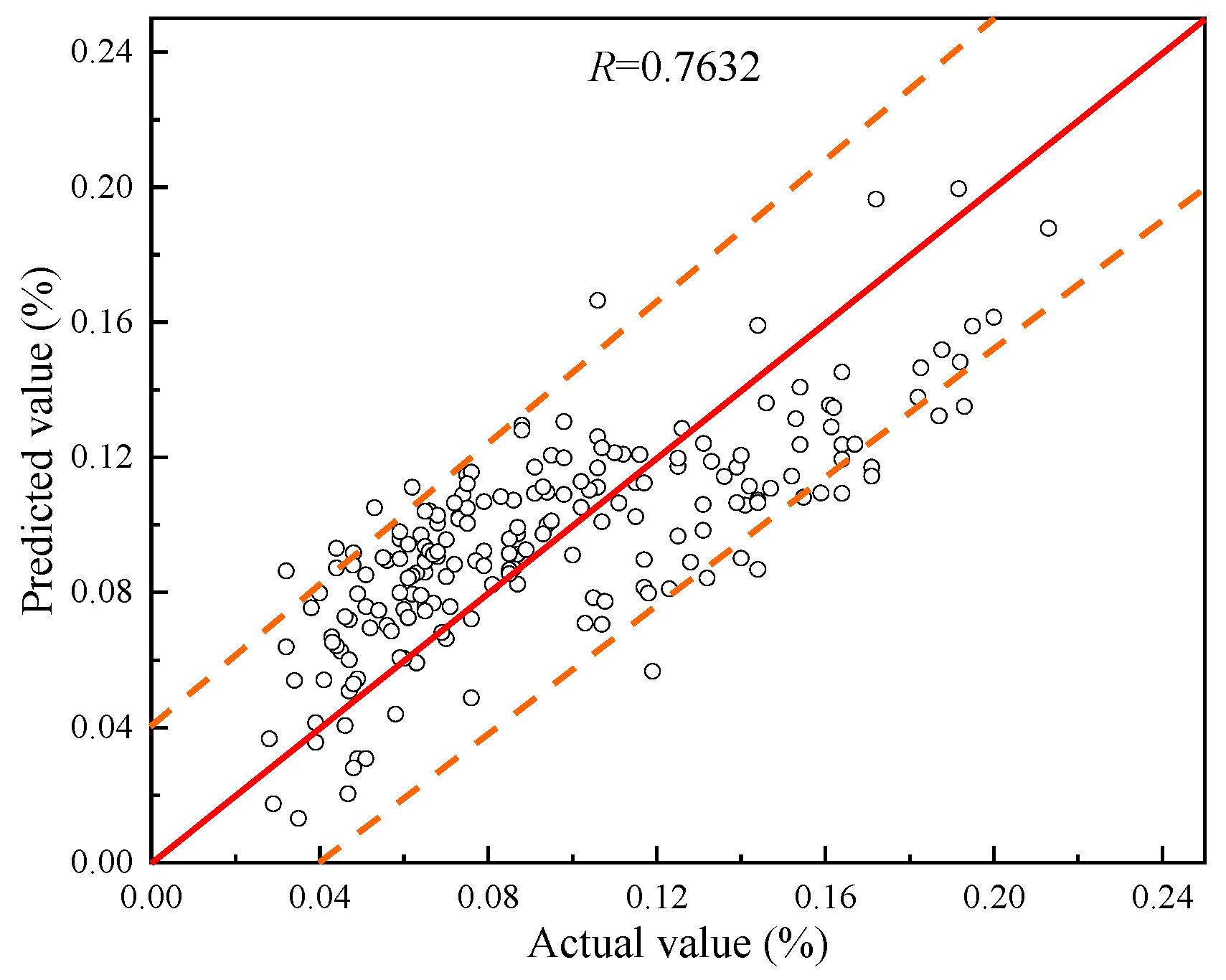
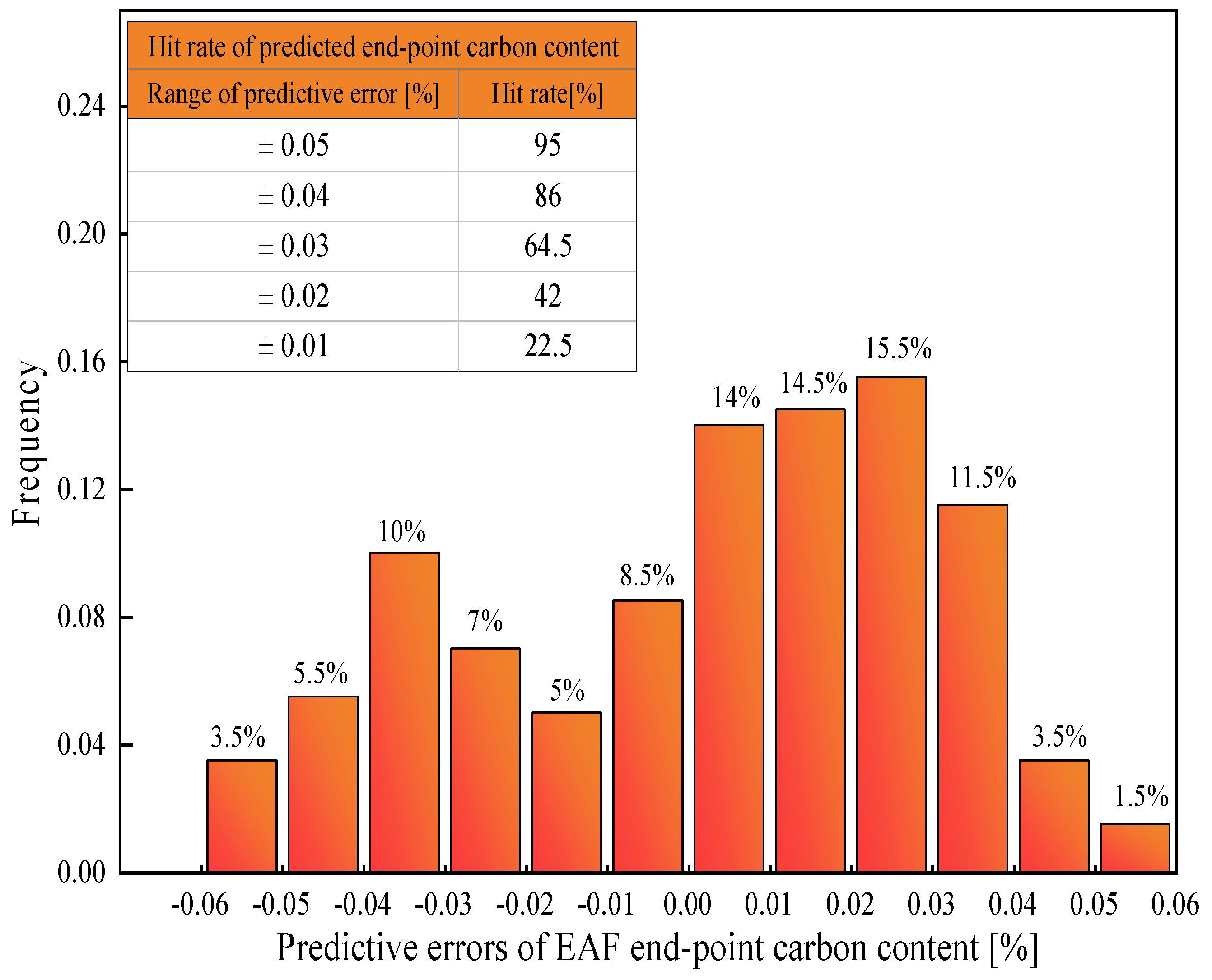



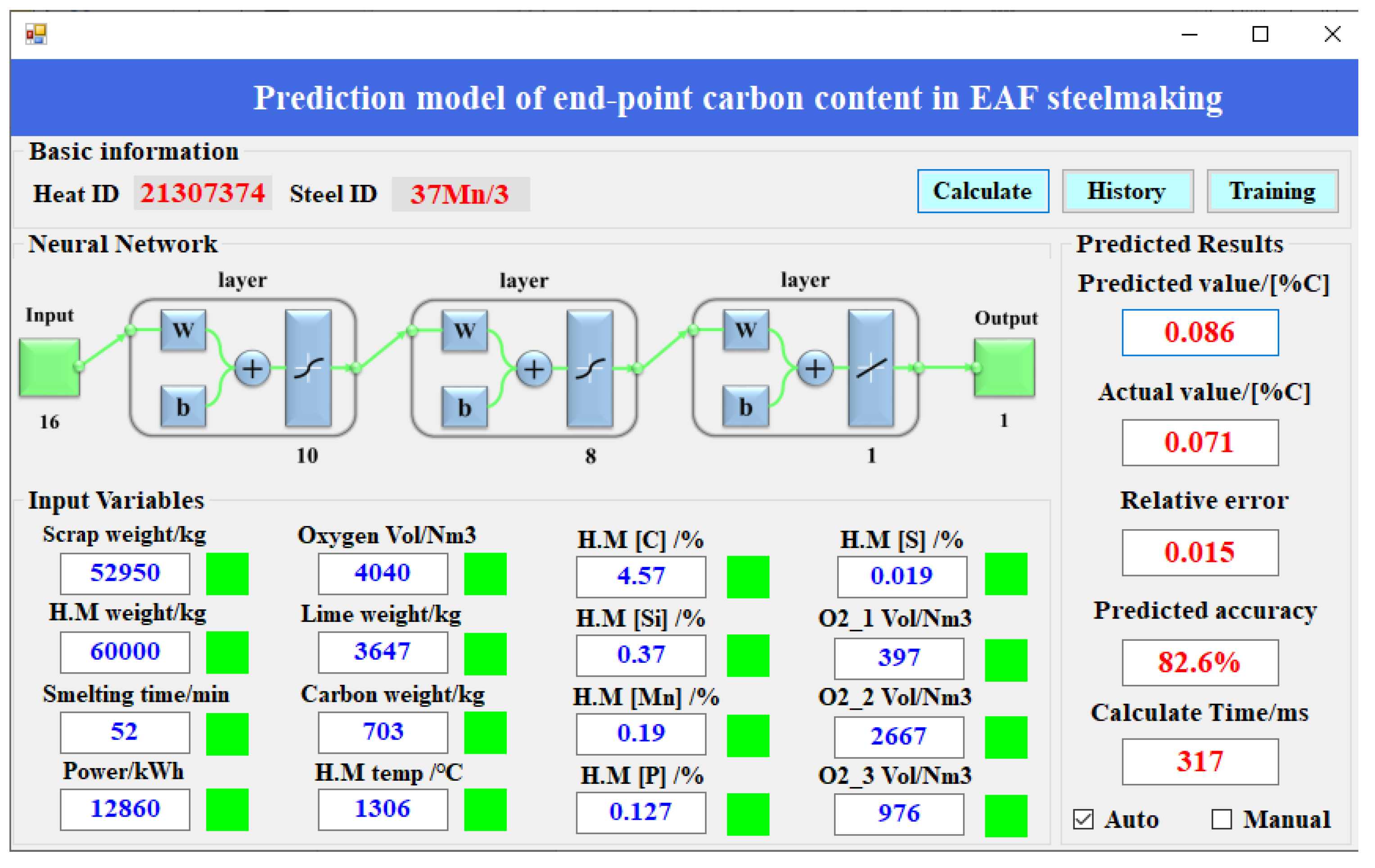
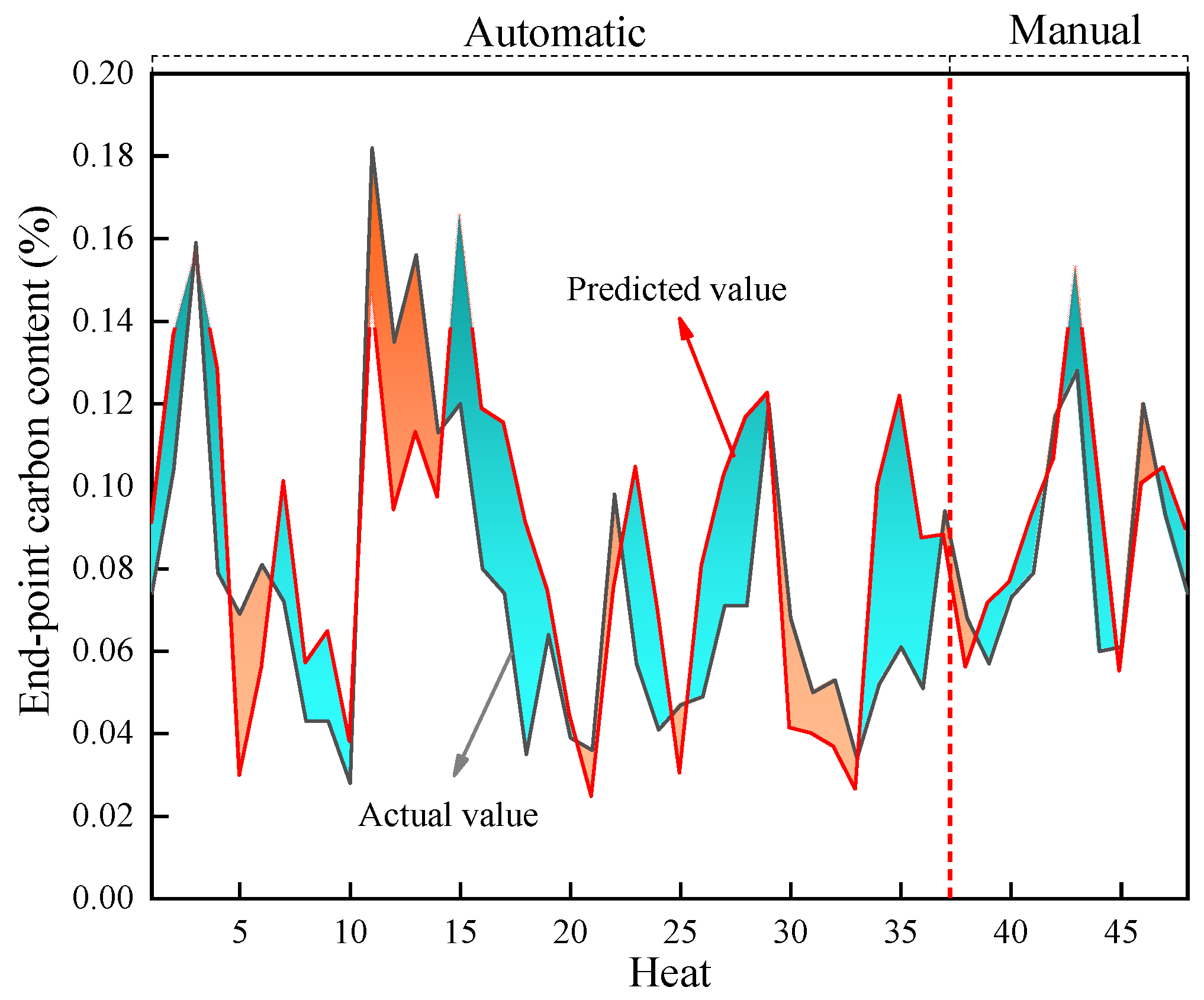
| Variables | Symbols | Units | Mean | Minimum | Maximum | Standard Deviation |
|---|---|---|---|---|---|---|
| scrap weight | X1 | t | 54.69 | 14.7 | 83.2 | 11.82 |
| hot metal weight | X2 | t | 63.18 | 39 | 100 | 9.22 |
| hot metal [C] content | X3 | % | 4.54 | 4.35 | 4.70 | 0.02 |
| hot metal [Si] content | X4 | % | 0.42 | 0.16 | 0.93 | 0.12 |
| hot metal [Mn] content | X5 | % | 0.22 | 0.12 | 0.43 | 0.06 |
| hot metal [P] content | X6 | % | 0.13 | 0.08 | 0.21 | 0.02 |
| hot metal [S] content | X7 | % | 0.02 | 0.00 | 0.05 | 0.01 |
| hot metal temperature | X8 | °C | 1315.2 | 1202 | 1375 | 17.26 |
| smelting time | X9 | Min | 61.61 | 17.8 | 118.8 | 13.36 |
| carbon weight | X10 | Kg | 395.62 | 0 | 1603 | 247.11 |
| lime weight | X11 | Kg | 5504.48 | 2618.95 | 24247.9 | 1314.81 |
| electric energy | X12 | kJ | 16766.8 | 320 | 33760 | 5731.13 |
| oxygen volume | X13 | m3 | 4142.52 | 1671 | 6234.14 | 562.41 |
| oxygen first | X14 | m3 | 1194.52 | 1.02 | 4419 | 1014.65 |
| oxygen second | X15 | m3 | 2175.76 | 0.06 | 4535 | 936.33 |
| oxygen last | X16 | m3 | 775.32 | 0.00 | 4613.59 | 659.93 |
| end-point Carbon content | Z | % | 0.09 | 0.02 | 0.2 | 0.04 |
| - | X1 | X2 | X3 | X4 | X5 | X6 | X7 | X8 | X9 | X10 | X11 | X12 | X13 |
| X1 | −0.015 | 1.000 | |||||||||||
| X2 | 0.057 | −0.033 | 1.000 | ||||||||||
| X3 | −0.155 | 0.039 | 0.389 | 1.000 | |||||||||
| X4 | −0.076 | 0.037 | 0.696 | 0.451 | 1.000 | ||||||||
| X5 | −0.047 | −0.004 | −0.652 | −0.454 | −0.502 | 1.000 | |||||||
| X6 | −0.205 | 0.041 | 0.076 | 0.078 | 0.080 | −0.100 | 1.000 | ||||||
| X7 | −0.950 | 0.017 | −0.091 | 0.139 | 0.035 | 0.044 | 0.186 | 1.000 | |||||
| X8 | 0.981 | −0.018 | 0.076 | −0.149 | −0.055 | −0.045 | −0.197 | −0.992 | 1.000 | ||||
| X9 | −0.677 | 0.017 | −0.133 | 0.057 | −0.043 | 0.126 | −0.096 | 0.697 | −0.696 | 1.000 | |||
| X10 | 0.145 | −0.033 | 0.043 | −0.017 | −0.012 | −0.022 | −0.049 | −0.149 | 0.150 | 0.003 | 1.000 | ||
| X11 | 0.128 | −0.041 | 0.027 | 0.006 | −0.013 | −0.001 | −0.063 | −0.101 | 0.114 | 0.035 | 0.487 | 1.000 | |
| X12 | 0.076 | 0.004 | −0.019 | −0.024 | −0.054 | 0.001 | −0.040 | 0.053 | −0.002 | 0.007 | −0.134 | −0.087 | 1.000 |
| X13 | −0.178 | 0.026 | −0.066 | 0.042 | −0.013 | 0.094 | −0.142 | 0.164 | −0.170 | 0.397 | 0.298 | 0.145 | −0.026 |
| Z | 0.159 | −0.178 | 0.013 | 0.092 | 0.043 | −0.039 | 0.074 | −0.172 | 0.003 | −0.278 | −0.072 | −0.260 | 0.276 |
Publisher’s Note: MDPI stays neutral with regard to jurisdictional claims in published maps and institutional affiliations. |
© 2022 by the authors. Licensee MDPI, Basel, Switzerland. This article is an open access article distributed under the terms and conditions of the Creative Commons Attribution (CC BY) license (https://creativecommons.org/licenses/by/4.0/).
Share and Cite
Yang, L.; Li, B.; Guo, Y.; Wang, S.; Xue, B.; Hu, S. Influence Factor Analysis and Prediction Model of End-Point Carbon Content Based on Artificial Neural Network in Electric Arc Furnace Steelmaking Process. Coatings 2022, 12, 1508. https://doi.org/10.3390/coatings12101508
Yang L, Li B, Guo Y, Wang S, Xue B, Hu S. Influence Factor Analysis and Prediction Model of End-Point Carbon Content Based on Artificial Neural Network in Electric Arc Furnace Steelmaking Process. Coatings. 2022; 12(10):1508. https://doi.org/10.3390/coatings12101508
Chicago/Turabian StyleYang, Lingzhi, Bo Li, Yufeng Guo, Shuai Wang, Botao Xue, and Shaoyan Hu. 2022. "Influence Factor Analysis and Prediction Model of End-Point Carbon Content Based on Artificial Neural Network in Electric Arc Furnace Steelmaking Process" Coatings 12, no. 10: 1508. https://doi.org/10.3390/coatings12101508






